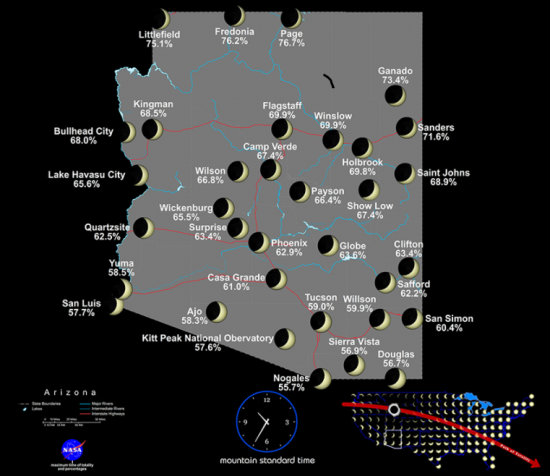by Paula Fierros

On Monday, August 21, 2017, hundreds of our Pueblo Warriors witnessed their first significant solar eclipse. Although Tucson was able to view just a partial eclipse, for many it was a cosmic experience.

A solar eclipse an astronomical phenomenon that occurs when the moon passes between earth and the sun—thereby totally or partly obscuring the image of the sun for a viewer on earth. A total solar eclipse occurs when the moon’s apparent diameter is larger than the sun’s, blocking all direct sunlight, turning day into darkness. Totality occurs in a narrow path across earth’s surface, with the partial solar eclipse visible over a surrounding region thousands of kilometers wide.

This year’s total eclipse was visible to tens of millions of Americans—from Oregon to South Carolina.
Dr. Lolly Levine, one of Pueblo’s science teachers, was able to travel to Glendo State Park in Wyoming, to view the total eclipse.
“During the total eclipse moment, the sky became very dark, and the temperature drastically dropped down to 10 degrees!” Levine said. “The eclipse was heavenly—it gave me goose bumps. No clouds—the sky was perfect. The eclipse was definitely an experience of a lifetime.”
Back here at Pueblo, Tucsonans were able to view about 59% of the eclipse.

Junior Andrew Romero said, “Only in [partial or total] darkness is when we can truly see the beauty outside our little blue planet that we call ‘home’.”
Ismael Altamirano, a senior, said that the eclipse was a “phenomenal” experience. “However, I really hated sharing my glasses with sweaty strangers.”
Another student, senior Riana Lara, said, “The eclipse was a beautiful sight to see—so amazing to have a total eclipse in this country after so many years.”
Science teacher, Ms. Wilma Amaro said “[The eclipse was] auspicious.”
Campus monitor Ms. Nellie Rivera said, “I thought [the eclipse] was more hyped than it was supposed to be, but at least it brought people together.”
Senior Calista Gonzales said, “The eclipse was lit!”
Unfortunately, not all Warriors were able to see the eclipse. Pueblo’s principal Dr. Augustine Romero announced to the school that unless students had parental permission—and had exclusive solar eclipse glasses that safely allowed students to view the eclipse—students were not permitted to leave their classrooms. Some teachers, too, did not release students during the peak time of the eclipse in Tucson—at 10:36 a.m.—which coincided with third period.
Senior Mercedes Sanchez said, “I was locked in a classroom during the eclipse.”
Vivi Cruz, another senior, was saddened that her teacher would not allow her to leave class to view the eclipse. “I heard that we were suppose to have permission slips in order to view the eclipse,” Cruz said, “and I didn’t have the special glasses. I heard that there will be another solar eclipse near Arizona [passing through Northern Mexico into Texas and beyond] in 2024, so maybe I can see that one.”
Math teacher Mr. Gregory Obregon said, “I missed the peak [of the eclipse]. I wasn’t able to go up to Nebraska to see the total—eclipse.”
Some Warriors are “old enough” to recall the February 26, 1979 eclipse, which was the last total eclipse in the United States prior to the 2017 event. Unfortunately, only the northwestern states experienced a total eclipse; Arizona, was able to view another partial 38 years ago.
Dr. Romero, principal, said, “This eclipse was not my first. I was in sixth grade back in 1979, and I think the first eclipse is always the most impressive and historical. Still, the eclipse [this year] was very interesting, and I got to view it with glasses—to see the crescent-shaped sun.”
Mr. Rana Medhi, English and journalism teacher, said, “I was a junior in high school during the big ’79 eclipse—still I remember my algebra class going outside to view it. In those days, nobody made a big deal out of wearing special glasses. Maybe that’s why everybody needed glasses before graduation day in 1980.” He paused and said, “I’ve never seen a total eclipse, but I’d like to before I die.”

Although there have been total eclipses in the United States in the past century, this was the first to coast-to-coast event in 99 years. The next U.S. coast-to-coast total eclipse won’t occur until August 12, 2045, according to NASA.
However, there will be total eclipses in the United States that won’t be bi-coastal, including the event on April 8, 2024, just seven years from now—visible from northern Mexico and extending into central Texas and stretching all of the way up to New England. Many Warriors are already saving their money for that event.

“Texas isn’t that far from Arizona,” said senior Calista Gonzales, “and I plan to make a road trip with my friends to Austin or San Antonio to see the total eclipse! Heck yeah!”
Some students wanted the event to last longer.
Senior Alina Perez said, “I waited so long to watch something [that lasted] so short.”











